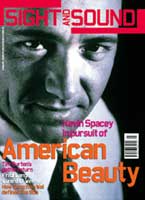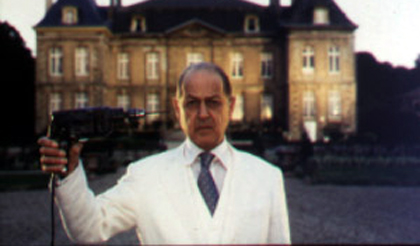Primary navigation

Netherlands/UK/Luxembourg 1999

Reviewed by Richard Falcon
Our synopses give away the plot in full, including surprise twists.
Tokyo, the present. Businessman Philip Emmenthal acquires eight and a half pachinko parlours. He puts his son Storey in charge. During an earthquake, Storey learns his mother has died. He returns to the family chateau in Geneva to nurse Philip through his grief. There he sleeps with Philip, introduces him to Fellini films and persuades him to convert the chateau into a private bordello. In Japan, aided by Storey's female interpreter Kito, Storey first recruits Simato, a pachinko addict. At a kabuki-theatre performance, they persuade Mio, a woman who aspires to the femininity epitomised by kabuki transvestites, to join the harem along with Kito. Storey and Philip have a ménage à trois with Simato.
Back in Geneva, Philip blackmails bank teller Griselda into becoming the lascivious nun of his fantasies. After injuring horse thief and pig-lover Beryl in a road accident, he and Storey coerce her into joining the bordello. They also acquire Giaconda, a fecund Italian. Clothilde, a female servant at the chateau, plots revenge, while con-artist Palmira lays down her terms for becoming one of the eight and a half women, a number completed by a "half-woman" named Giulietta. The bordello soon begins to unravel. Simato financially exploits the other women. Mio commits suicide. Giaconda is dispatched to South America. Clothilde attempts to poison Philip but only kills Beryl's pig. Beryl rides off. Griselda becomes a real nun and Kito is killed in an earthquake. Philip dies happy in bed with Palmira who then rejects Storey and leaves him alone with Giulietta. A final earthquake rocks Geneva.
Tokyo, the present. Businessman Philip Emmenthal acquires eight and a half pachinko parlours. He puts his son Storey in charge. During an earthquake, Storey learns his mother has died. He returns to the family chateau in Geneva to nurse Philip through his grief. There he sleeps with Philip, introduces him to Fellini films and persuades him to convert the chateau into a private bordello. In Japan, aided by Storey's female interpreter Kito, Storey first recruits Simato, a pachinko addict. At a kabuki-theatre performance, they persuade Mio, a woman who aspires to the femininity epitomised by kabuki transvestites, to join the harem along with Kito. Storey and Philip have a ménage à trois with Simato.
Back in Geneva, Philip blackmails bank teller Griselda into becoming the lascivious nun of his fantasies. After injuring horse thief and pig-lover Beryl in a road accident, he and Storey coerce her into joining the bordello. They also acquire Giaconda, a fecund Italian. Clothilde, a female servant at the chateau, plots revenge, while con-artist Palmira lays down her terms for becoming one of the eight and a half women, a number completed by a "half-woman" named Giulietta. The bordello soon begins to unravel. Simato financially exploits the other women. Mio commits suicide. Giaconda is dispatched to South America. Clothilde attempts to poison Philip but only kills Beryl's pig. Beryl rides off. Griselda becomes a real nun and Kito is killed in an earthquake. Philip dies happy in bed with Palmira who then rejects Storey and leaves him alone with Giulietta. A final earthquake rocks Geneva.
8 1/2 Women sets out its organising principles in the title while the director Peter Greenaway offers in the press notes his customary auto-exegesis for baffled critics, explaining that the film is constructed around an intentionally comic parade of eight and a half archetypes of male sexual fantasy, as represented in western art practice down the ages. For each figure, a list of artists could be matched. Griselda's chaste nun in starched linen? Try Rembrandt, Diderot and de Sade. The Madame Butterfly syndrome of the oriental female used and abandoned by a western male? How about Delacroix, Ingres, Flaubert and Matisse? It is also intended as a comic (a word not readily associated with Greenaway) homage to both Fellini and Godard. But at the same time it is his conceptually thinnest and visually least ravishing film.
As a comic meditation on cinema's contribution to the topography of male fantasy, 8 1/2 Women begins - in very Godardian fashion - with money as Philip signs a contract transferring ownership of some pachinko parlours to him. The pachinko parlours with their little silver balls are the first comic link between money and sex in the chain of financial exchanges that transforms Philip's Geneva chateau into a brothel. Philip, unlike the earlier hubristic Greenaway technocrats (draughtsmen, natural historians, architects and so on), is a grieving businessman. But as in a Zed & Two Noughts, this grief instigates a deviation towards taboo rather than condolence and reassurance, which Greenaway has always disliked in "dominant cinema". The Vermeer-like composition of Philip next to his wife's deathbed and the misogyny of Philip's comment that she was asleep when their son Storey was conceived are chilly moments leading to the film's most perverse and effective sequence when father and son sleep together. It's an act which recommends itself to Greenaway because, unlike sons sleeping with their mothers, it's something which supposedly "has no name".
Philip's views on conventional cinema seem very close to Greenaway's: "I hate the cinema," he confides to Storey. "Everybody feeling the same thing at the same time. It's too intimate." Video, however, allows Storey to talk Philip into sexual experimentation: lying together on a bed like teenagers, watching a tape of Fellini's 8 1/2, Philip is curious about the number of film-makers who make films to satisfy their sexual fantasies. "All of them," replies Storey. (His bedroom in Japan, in contrast with Philip's book-lined chateau, is full of television monitors; the relative absence of the written word here along with the film's frequent close-ups also set this apart from recent Greenaway films.) When the pair's private bordello is up and running, Philip explicitly links it to what used to be termed the 'plenitude' offered by the cinematic apparatus: "Most films are about what people haven't got: sex and happiness. We have them both." Unfortunately, given the film's lack of eroticism, a more resonant moment for many will be the one when father and son compare bodies in front of a mirror and Storey wonders whether "all this narcissism is really boring."
The invocation of Fellini is deeply ironic. 8 1/2 - centred on Fellini's alter ego Marcello Mastroianni's search for an actress to embody the ideal woman - pre-empted the allusive richness of Greenaway's cinema. Fellini's vitality and profound scepticism towards intellectualism as a solution to the creative impasse there seem worlds apart from Greenaway's aloof taxonomy. The fetishistic perspex corset worn by pig-loving Beryl after her fall from her horse and the wheelchair-bound "half-woman" Giulietta (seemingly named after Fellini's wife Guilietta Masina) seem a curiously insulting form of homage, closer to Cronenberg's Crash than Fellini. The final chapter of this saga - the destruction of the bordello - is intended to invoke Godard's recent deconstruction of cinema: the reason why, for Greenaway, we cannot return to the art cinema of Fellini. This is territory many will feel Greenaway has investigated more successfully outside cinema, for example in his grandiose installation In the Dark for the Spellbound exhibition at London's Hayward Gallery which broke film-making down into its constituent parts in Godardian fashion.
Perhaps to counter inevitable charges of misogyny, the women in the film's climax take charge again. However, the terms of this female revenge smack also of male self-pity ("Men love women, women love children, children love hamsters - it's a one-way street," Palmira tells the other women). Maybe the strongest impression left by 8 1/2 Women is that the constraints of the feature film against which Greenaway has always chafed have led him to paint himself into the kind of misanthropic self-referential corner his other films always narrowly avoided. Ultimately, these men behaving badly are comically indulged: Philip dies in bed with his dream woman, and Storey, left alone with the half-woman of the narcissistic, male, erotic-cinematic imagination, has the earth move for him.